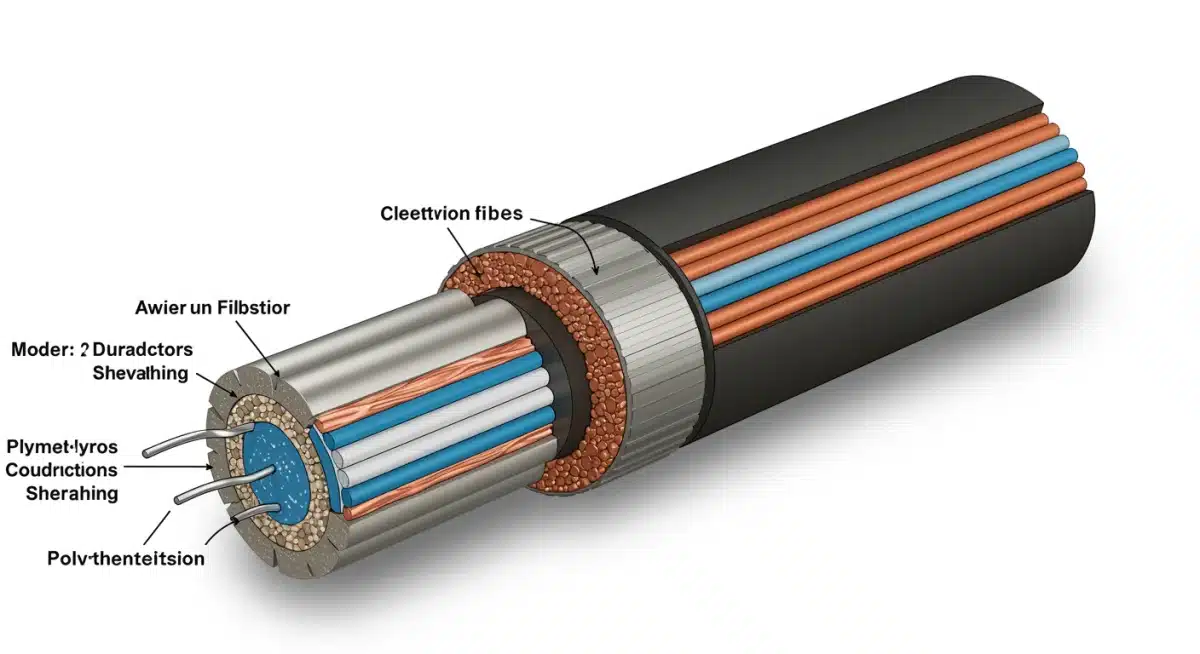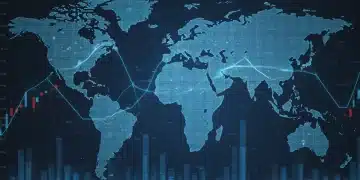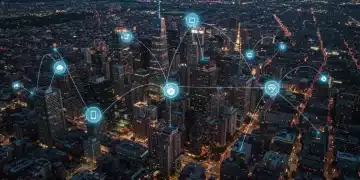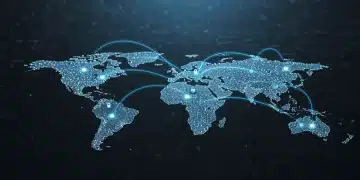New Submarine Cable Projects 2025: US-Asia Connectivity Surges

Recent updates confirm that New Submarine Cable Projects in 2025: Boosting US-Asia Connectivity by 30% are rapidly progressing, poised to revolutionize global internet infrastructure. These ambitious endeavors are set to significantly enhance data transfer capabilities between North America and Asia, addressing the escalating demand for high-speed, reliable digital communication.
Unprecedented Investment in Trans-Pacific Networks
The global telecommunications industry is witnessing an unprecedented surge in investment directed towards new trans-Pacific submarine cable systems. This strategic focus aims to fortify digital pathways, ensuring robust and resilient internet services across continents. Companies are pouring billions into these projects, recognizing the critical role they play in the evolving digital economy.
Driving Forces Behind the Expansion
Several key factors are propelling this massive expansion. The exponential growth of cloud computing, the proliferation of artificial intelligence, and the increasing demand for streaming services are all contributing to an insatiable need for greater bandwidth. Geopolitical considerations also play a significant role, with nations seeking to secure their digital sovereignty and diversify connectivity routes.
- Increased Data Consumption: Global data traffic is projected to double every few years, necessitating more robust infrastructure.
- Cloud Services Growth: Major cloud providers are expanding their global footprints, requiring direct, high-capacity links.
- AI and Big Data: The processing and transfer of massive datasets for AI applications demand ultra-low latency and high bandwidth.
- Geopolitical Stability: Diversifying cable routes enhances resilience against natural disasters or geopolitical disruptions.
Key Projects Slated for 2025 Completion
Several major submarine cable projects are on track for completion and activation in 2025, promising a substantial boost to US-Asia connectivity. These initiatives represent the cutting edge of fiber optic technology, designed to handle immense data volumes and reduce latency.
One notable project is the Apricot cable system, which aims to connect Japan, Taiwan, Guam, the Philippines, Indonesia, and Singapore, with onward connections to the US. Another significant development is the expansion of the Pacific Light Cable Network (PLCN), though facing regulatory hurdles, efforts continue to bring new segments online. These projects are not merely about increasing capacity; they are about creating a more interconnected and resilient global network.
The Hawaiki Nui System
The Hawaiki Nui cable system, an extension of the existing Hawaiki cable, is also a critical component of this expansion. It will further connect Australia, New Zealand, and Southeast Asia to the US, enhancing redundancy and capacity. Such systems are vital for supporting the burgeoning digital economies of the Asia-Pacific region and their deep integration with US markets.
Technological Advancements Enhancing Cable Performance
The new generation of submarine cables incorporates significant technological advancements that dramatically improve performance and longevity. These innovations are crucial for meeting future data demands and ensuring the reliability of these vital digital arteries. From advanced fiber optics to sophisticated branching units, every component is optimized for peak efficiency.
Modern cables utilize higher fiber counts and advanced modulation techniques, allowing for more data to be transmitted per fiber pair. This translates directly into greater overall capacity for the entire cable system. Furthermore, improvements in repeater technology enable signals to travel longer distances with less degradation, reducing the need for numerous repeaters and simplifying maintenance.

Enhanced Durability and Security
Beyond raw capacity, these new cables are designed with enhanced durability and security features. Improved sheathing materials and burial techniques protect against damage from fishing activities, ship anchors, and even seismic events. Cybersecurity measures are also being integrated from the design phase, safeguarding against potential disruptions and unauthorized access.
- Increased Fiber Count: More individual optical fibers within each cable, multiplying data capacity.
- Coherent Optical Technology: Advanced signal processing allows for higher data rates and spectral efficiency.
- Improved Repeater Design: Boosting signal strength over longer distances with greater reliability.
- Advanced Protection Layers: Enhanced armor and burial methods to resist external damage.
Economic and Geopolitical Impact of Increased Connectivity
The boost in US-Asia connectivity through these new submarine cables carries profound economic and geopolitical implications. Economically, it facilitates faster trade, supports e-commerce growth, and enables seamless collaboration between businesses and researchers across continents. This digital infrastructure underpins global supply chains and financial markets.
From a geopolitical standpoint, the development of these cables reflects a strategic effort to strengthen alliances and enhance communication pathways. It also highlights the ongoing competition for digital dominance and the importance of secure, resilient networks in an increasingly interconnected world. Nations are keen to ensure their populations and industries have access to reliable internet, fostering innovation and economic prosperity.
Fostering Digital Economies
The enhanced connectivity will particularly benefit emerging digital economies in Southeast Asia, providing them with the necessary bandwidth to compete on a global scale. This includes supporting startups, facilitating remote work, and expanding access to education and healthcare services through digital platforms. The ripple effect of improved internet access is vast and transformative.
Challenges and Mitigation Strategies
Despite the immense benefits, the deployment of new submarine cable projects is not without its challenges. The sheer scale of these undertakings, coupled with environmental considerations and complex regulatory landscapes, demands meticulous planning and execution. Overcoming these hurdles is crucial for the successful realization of these ambitious projects.
Environmental impact assessments are a critical part of the planning process, ensuring that cable laying operations minimize disruption to marine ecosystems. Navigating the diverse regulatory frameworks of multiple countries also presents a significant challenge, requiring extensive international cooperation and diplomatic efforts. Furthermore, securing adequate funding and skilled labor remains a constant consideration for developers.
Protecting Against Disruptions
Mitigation strategies include employing sophisticated route planning to avoid high-risk areas, investing in robust cable protection, and establishing rapid repair capabilities. International consortiums are often formed to share the financial burden and expertise, streamlining the development process and enhancing project resilience.
- Environmental Concerns: Minimizing impact on marine life and ecosystems during installation.
- Regulatory Hurdles: Navigating diverse national and international laws and permitting processes.
- Funding and Resources: Securing billions in investment and specialized engineering talent.
- Geopolitical Tensions: Addressing concerns about data sovereignty and potential surveillance.
Future Outlook: Beyond 2025
The completion of these 2025 projects marks a significant milestone, but the drive for greater global connectivity will undoubtedly continue. Looking beyond 2025, industry experts anticipate further investment in even higher-capacity systems, exploring new routes, and integrating advanced technologies like quantum communication. The digital landscape is constantly evolving, and infrastructure must keep pace.
Research and development in fiber optic technology continue to push the boundaries of data transmission. New materials and techniques promise even greater speeds and efficiencies. The focus will also shift towards creating a more interconnected mesh network, reducing reliance on single points of failure and enhancing overall network resilience. Submarine cables will remain the backbone of global internet for the foreseeable future.
Emerging Technologies and New Routes
Discussions are already underway for projects that will explore alternative routes, potentially through the Arctic, to offer even lower latency connections between major economic hubs. The integration of artificial intelligence into network management will also become more prevalent, optimizing data flow and predicting potential issues before they arise, ensuring uninterrupted service.
| Key Point | Brief Description |
|---|---|
| Connectivity Boost | New submarine cable projects in 2025 are projected to increase US-Asia connectivity by 30%. |
| Key Projects | Major systems like Apricot and Hawaiki Nui are set for completion, enhancing trans-Pacific links. |
| Technological Advances | Higher fiber counts, coherent optics, and enhanced protection improve cable performance and durability. |
| Impact | Significant economic growth, stronger geopolitical ties, and improved digital resilience are expected. |
Frequently Asked Questions About US-Asia Submarine Cables
New submarine cables are vital for meeting the surging demand for data, driven by cloud computing, AI, and streaming services. They provide essential bandwidth and lower latency, supporting economic growth and digital collaboration between the US and Asia, ensuring robust and reliable internet infrastructure for modern global communication needs.
Several key projects are anticipated for completion in 2025, including the Apricot cable system, which will connect various Asian nations to the US, and the expansion of the Hawaiki Nui system, further linking Oceania and Southeast Asia to North America, significantly boosting regional capacity.
These next-generation cables incorporate advanced technologies such as higher fiber counts, coherent optical technology for greater data rates, and improved repeater designs. These innovations collectively allow for significantly increased data transmission capacity and reduced signal degradation over vast distances, ensuring faster and more reliable connections.
The enhanced connectivity will spur economic growth by facilitating faster international trade, supporting the expansion of e-commerce, and enabling seamless digital collaboration for businesses. It also fosters innovation in technology sectors, creates new job opportunities, and integrates emerging digital economies more tightly into the global marketplace.
Submarine cable projects contend with significant challenges including environmental impact concerns during installation, navigating complex international regulatory frameworks, securing substantial funding, and managing geopolitical sensitivities. Developers employ advanced planning and international collaboration to mitigate these hurdles, ensuring successful deployment and operation.
What This Means
The ongoing development and anticipated completion of these new submarine cable projects by 2025 signal a pivotal moment in global digital infrastructure. This substantial increase in US-Asia connectivity by an estimated 30% is not merely a technical upgrade; it represents a strategic strengthening of economic and geopolitical ties. Businesses can expect faster, more reliable data transfer, facilitating expanded cloud services and AI development. For individuals, this translates to improved internet performance and access to global digital resources. The focus now shifts to ensuring the long-term security and resilience of these vital networks against evolving threats and increasing demand.





